IPTV/en: различия между версиями
Новая страница: «== '''IPTV Operation on WEB OS''' == Switching to IPTV mode on WEB OS is also done using the right or left buttons. The window with channels and categories remains visible for five seconds. IPTV can work with the following stream types: * HLS * MP4 via link (Starting with HTTP) * RTSP (There may be issues with sound and graphical artifacts) {{Note| UDP stream was not tested but is supported.|warn}} The following buttons are used for operating IPTV on the dev...» |
FuzzyBot (обсуждение | вклад) м FuzzyBot переименовал страницу Раздел IP - телевидение (IPTV)/en в IPTV/en без оставления перенаправления: Часть переводимой страницы Раздел IP - телевидение (IPTV). |
(нет различий)
| |
Версия от 15:36, 28 марта 2024
IP Television Section
A new section with useful functionality, "IP Television" (IPTV), has been introduced in the SmartPlayer personal account.
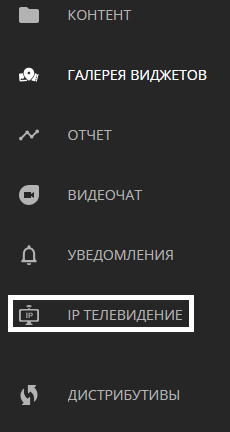
In this section, the user will be able to switch to IPTV mode from the SmartPlayer personal account and view the available channels.
Activating IPTV in the SmartPlayer Personal Account
To enable IPTV functionality within SmartPlayer, one needs to navigate to the "Devices" section of the personal account.
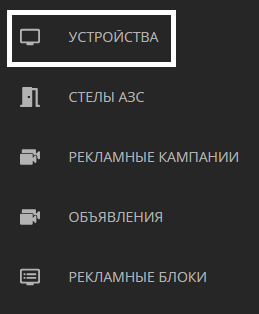
The next step is for the user to select the desired device from the list by clicking on it.
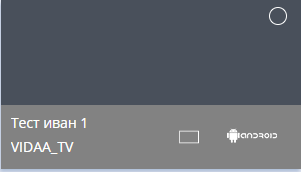
After selecting the device, the user needs to go to the sidebar on the right to configure the settings. In this sidebar, the user must select the "Settings" section.
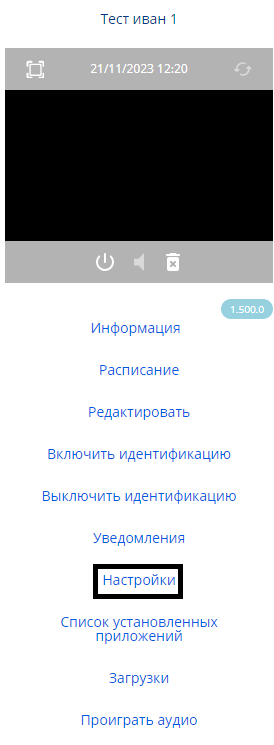
After navigating to settings, the user needs to find the "Content" section and click on it.
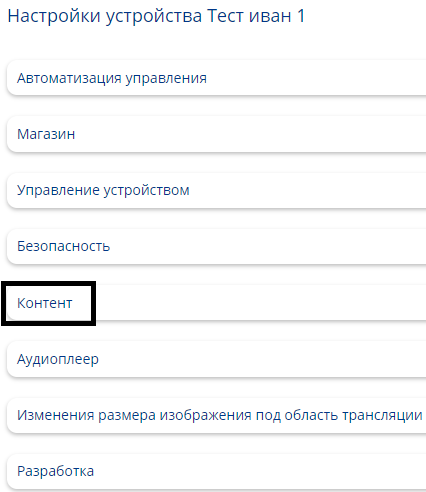
This section will expand, and the user will need to enable the "IP Television" option using the toggle switch.
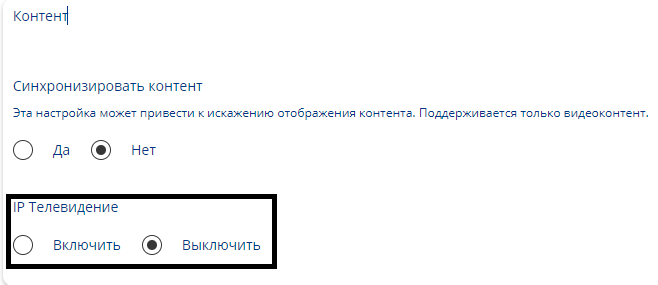
Then, the user needs to click the "Save Changes" button at the bottom of the screen.
Operating Logic
The user needs to enable the capability to use IPTV mode on the device through the device settings in their personal account (in this case, the server saves data about the enabling/disabling of IPTV mode).
After that, in the separate "IP Television" section of the personal account, the user needs to upload or configure channels for IPTV operation. When setting up channels and categories, the server saves the data into two different databases, which are used for IPTV operation. That is, upon requesting these databases, the server provides the information to the client application.
Having configured IPTV in the personal account, the user can launch it on the device and use IPTV for their needs using a remote control/input device. The user can also conclude the IPTV session using the remote control/input device.
Main Page
The next step for the user is to navigate to "IP Television". Upon accessing the "IP Television" section, the main page will be displayed to the user. On this page, three main blocks are available at the top:
- Channels
- Sections
- Upload

After configuring these blocks, the user will be able to start working with IPTV.
"Channels" Block
Within the "Channels" block, users can add new channels to the list for broadcasting in IPTV player mode and find ready-made channels using the search bar.

This action can be performed using the "+" icon located at the top left of the screen. Also, in this section of the page, users can delete a channel using the "Trash" icon, which is located next to the search bar.

To create a channel, the following parameters need to be specified:
- Name - allows entering the name of the channel.
- Number - allows specifying the channel number in the list. Important: channel numbering must not repeat, otherwise the channel cannot be created.
- IP address - this field is for entering the channel's URL that will be broadcasted.
- Category - users need to specify the category to which the channel belongs. This setting is not mandatory. Within the SmartPlayer platform, channels can exist without categories.
- Logo - allows selecting and setting an image for the channel as a logo.
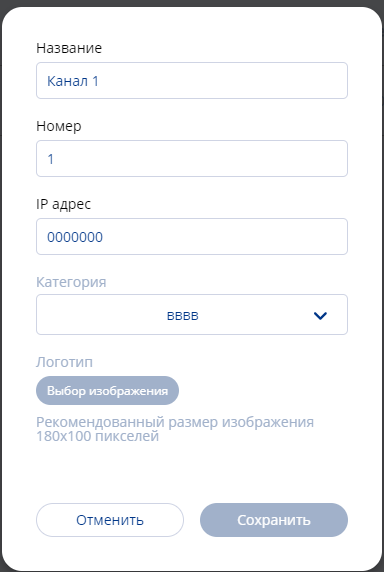
After filling in all the parameters mentioned above, users can create a channel by clicking the "Save" button. If necessary, users can return to the previous window by clicking the "Cancel" button. If a user has a channel they no longer need, they can delete it by clicking on the "Trash" icon, also located at the top left. Before doing this, they need to select the channel using a checkbox.

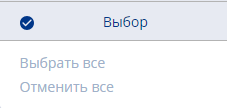
"Categories" Block
In the "Categories" block, users can view the available sections for storing channels.

If there are many sections, users can utilize the search bar.
Users can also add a new section within this block. This action can be performed using the "+" icon at the top left of the screen. When creating a section, it's necessary to specify its name.
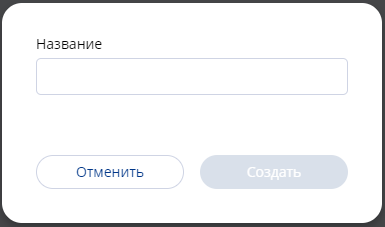
If a user has a channel they no longer need, they can delete it by clicking on the "Trash" icon, also located at the top left. Before this action, they need to select the channel using a checkbox.


"Upload" Block
In this block, users can upload and download a ".csv" file with a prepared list of channels.

This feature is relevant for users who have a large number of channels to upload.
For the correct upload of channels, it is necessary to:
- Select a file on the device (by default, a ".csv" file is uploaded and downloaded)
- Specify a delimiter for the data (default is ",")
- Choose one of two encodings (UTF-8 or Windows 1251)

IPTV Operation on Android OS
After enabling and configuring IPTV in the personal account, the user can press and hold the central "OK" button on the remote for 5 seconds to launch IPTV mode.
If the user has configured channels (as described earlier in the article about IPTV settings in the personal account), then IPTV will start operating normally. If the channels were not added, switching to IPTV mode will result in a black screen.
IPTV on Android OS can operate with the following stream types:
- HLS
- SmoothStream
- DASH
- UDP
- HTTP
The following buttons are used for operating IPTV on the device:
- The "OK" button/single press of the "Up" button/single press of the "Down" button - opens the side menu with channels. The side menu will close after five seconds of inactivity.
- A single press of the "Left" button/single press of the "Right" button - opens the channel categories catalog. This menu will close after fifteen seconds of inactivity.
- The "Back" button - closes the above menus/takes a step back. This button also allows turning off IPTV mode when pressed during channel playback.
Subtleties and Nuances When Operating on Android OS
- When adding a YouTube stream as a channel, use the link from the address bar, not the "Share" button in the YouTube menu.
- In the channel switching menu, when moving to the next channel (highlighting it without switching), the system will automatically switch to the highlighted channel after one second.
- An error may appear in the center of the screen during channel operation, and the channel playback may stop. In this case, the user needs to switch to another channel.
IPTV Operation on WEB OS
Switching to IPTV mode on WEB OS is also done using the right or left buttons. The window with channels and categories remains visible for five seconds. IPTV can work with the following stream types:
- HLS
- MP4 via link (Starting with HTTP)
- RTSP (There may be issues with sound and graphical artifacts)
The following buttons are used for operating IPTV on the device:
- A single press of the "Left"/"Right" button - opens the catalog with channel categories.
- A single press of the "Up"/"Down" button - opens the side channel menu.
- Pressing the "OK" button - allows selecting the highlighted channel or category.
The "0" button - turns off IPTV mode on the device.
Subtleties and Nuances When Operating with WEB OS
- Streaming from YouTube is parsed not through the address bar but using the link from the "Share" button.
- If an invalid data stream is received, only a black screen will be displayed.
Example of Channel and Category Display in Operating IPTV
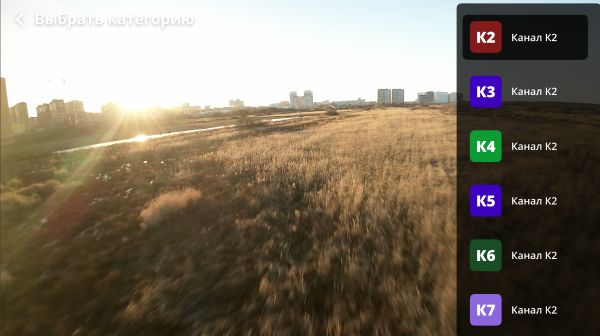
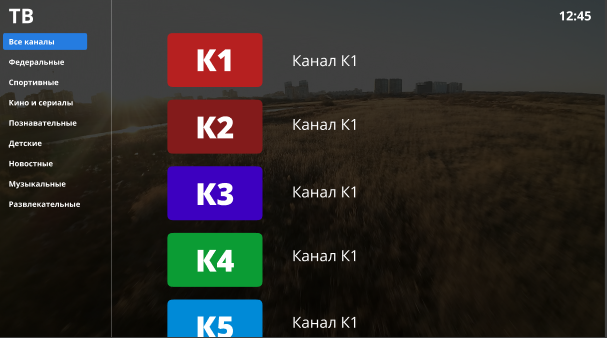
Final Outcome
The user understands, knows, and is able to use the IPTV functionality in the SmartPlayer platform's personal account. The acquired knowledge will allow them to use this feature for implementing several operating modes of the device.